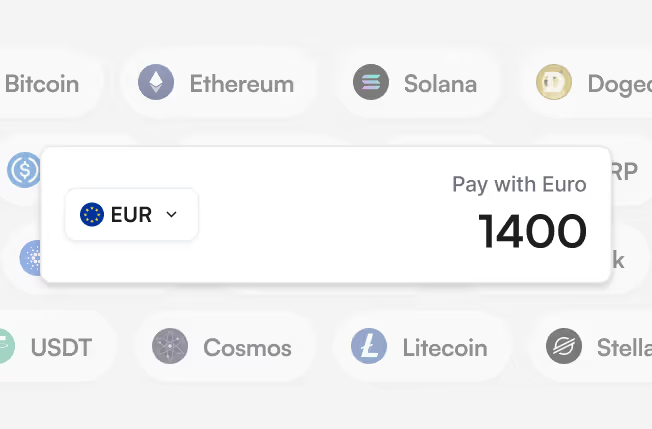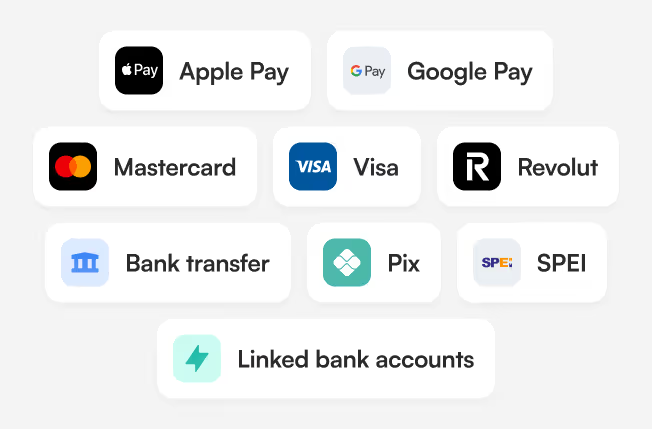
Buy Polkadot instantly, delivered to your wallet.
Easily purchase Polkadot using credit or debit cards, Apple Pay, Google Pay, or bank transfers. Fast checkout and secure delivery to any wallet or exchange account.


.svg)








Easily purchase Polkadot using credit or debit cards, Apple Pay, Google Pay, or bank transfers. Fast checkout and secure delivery to any wallet or exchange account.


.svg)







Buy Polkadot (DOT) quickly and securely – no exchange account needed. Simple for beginners, efficient for experienced users.

1
Enter how much Polkadot you want to purchase, or set the value in your local currency. Live pricing updates ensure you always see the current DOT rate.

2
Sign up using your preferred method and confirm your country of residence before continuing.

3
Have DOT sent directly to your chosen wallet – whether it’s a self-custodial option like Ledger or a custodial exchange account.

4
Pay with credit or debit cards, Apple Pay, Google Pay, bank transfers, or local payment services available in your region.

Ramp Network lets you connect both self-custodial wallets such as Ledger or Polkadot.js and custodial exchange accounts. When you purchase DOT, you simply select the destination, and your coins are sent directly.






The flow is kept simple and intuitive. Ramp Network avoids heavy blockchain jargon so that anyone can start buying Polkadot with confidence.
DOT is delivered straight to the wallet address you provide. Ramp Network never keeps custody of your assets, helping reduce the risks linked to third-party storage.
Ramp Network operates in multiple regions, including the UK, EU, and US. Availability may differ by location and is shown during checkout.

Before confirming your DOT purchase, you’ll see a full cost breakdown, including network fees. All amounts are displayed clearly at checkout.
*When compared to transferring via an exchange
Polkadot showed up in 2020 with a different vibe. Instead of claiming it would replace Ethereum, it asked a simpler question: why can’t blockchains just talk to each other?
That idea turned into the Relay Chain, Polkadot’s backbone. Picture it like a busy train station. Parachains come and go, each running its own schedule, but they all plug into the same tracks for security and communication. It’s messy in theory, but in practice it works surprisingly well.
DOT, the network’s token, is what keeps the trains running. People stake it to keep validators honest. They use it to vote on upgrades. New parachains literally need DOT to lock in before they launch. No DOT, no Polkadot. Simple as that.
So why do people buy it? Some are betting on interoperability – the idea that the future of Web3 is not one chain to rule them all, but dozens of chains working side by side. Others just want exposure to one of the most active developer ecosystems around. Either way, DOT has carved out a role that feels less like speculation and more like building the plumbing of a new internet.
Bitcoin (BTC) is the world’s first cryptocurrency, launched in 2009 by the mysterious creator known as Satoshi Nakamoto. Built on blockchain technology, Bitcoin introduced a new way of transferring value online without the need for banks or intermediaries. Its decentralized nature, combined with a fixed supply of 21 million coins, makes it a unique digital asset often referred to as “digital gold.”
Today, Bitcoin is the most recognized and widely used cryptocurrency worldwide. Millions of people use it for trading, investing, and cross-border payments, while businesses across industries accept Bitcoin payments as a secure and transparent alternative to traditional money. Its popularity continues to grow, supported by increasing adoption from financial institutions, mainstream investors, and even governments exploring Bitcoin regulation.
What makes Bitcoin special is its combination of scarcity, security, and decentralization. Unlike fiat currencies that can be printed endlessly, Bitcoin’s supply is limited, creating long-term value potential. Its blockchain is maintained by thousands of nodes across the globe, ensuring transactions remain transparent and resistant to censorship. For many users, Bitcoin represents more than just an investment — it’s a revolutionary step toward financial freedom and the future of money.
The chart displays an indicative, mid-market exchange rate. Effective exchange rate might be different.
Customers like you have traded over $1 billion in crypto with Ramp Network.